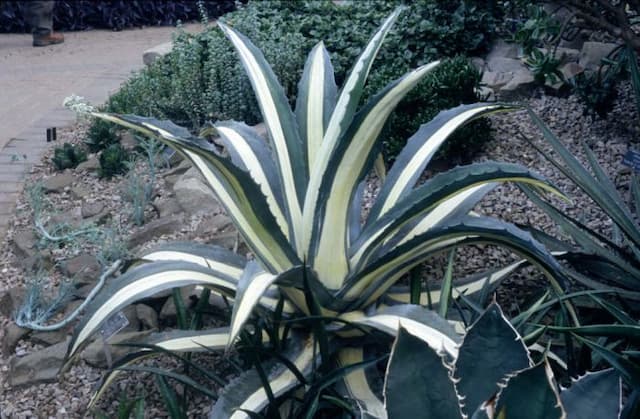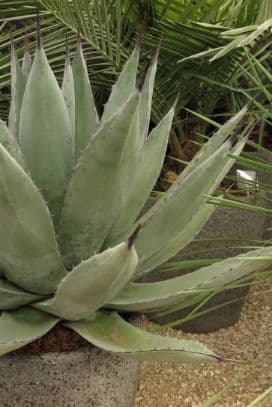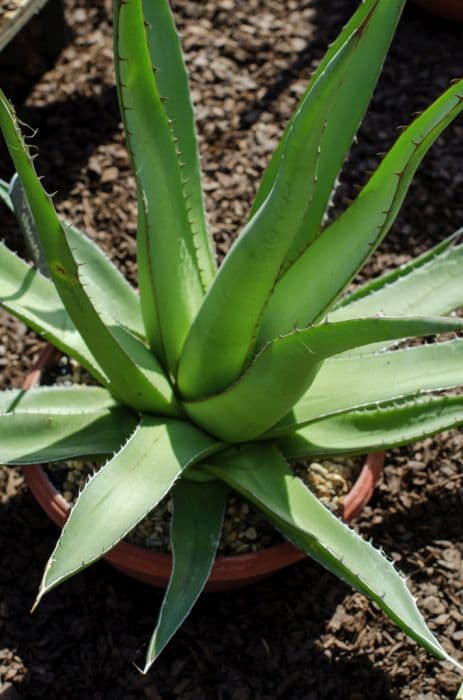Plantain Lily Hosta sieboldiana

ABOUT
The plant commonly known as Hosta or Plantain Lily typically has a lush, foliage-centric appearance, featuring broad leaves that are heart-shaped and often display a slight puckering. The leaves are generally a deep blue-green color, giving the plant a robust and vibrant look. As the plant matures, the leaves can develop into more of a mound-like form, creating an appealing visual texture in garden spaces. During its blooming period, Hosta puts forth tall flower stalks that rise above the foliage, adorned with bell-shaped flowers. These flowers can vary in color but are frequently found in shades of lavender or white, adding a delicate contrast to the dense foliage below. The Plantain Lily thrives in shaded areas where it can often be found contributing to the understory of larger plants or trees. It is favored for its ornamental leaves that serve as a beautiful backdrop for other plants or as a standalone specimen in a shade garden. The contrast between its richly colored foliage and the graceful flowers it produces makes it a popular choice for gardeners looking to add a touch of elegance to their outdoor spaces.
About this plant
 Names
NamesSynonyms
Plantain Lily, Giboshi
Common names
Hosta sieboldiana var. sieboldiana, Funkia sieboldiana.
 Toxicity
ToxicityTo humans
Hosta, the common name for Hosta sieboldiana, is generally recognized as safe for humans. It is not considered poisonous, and there are no commonly reported symptoms of poisoning from ingesting this plant. Nevertheless, it is always prudent to avoid eating plants not specifically grown or identified as food due to potential individual allergies or unexpected reactions.
To pets
Hosta is toxic to pets, such as cats and dogs. If pets ingest any part of the Hosta plant, they may experience symptoms of poisoning which can include vomiting, diarrhea, and depression. In severe cases, ingestion can lead to more significant effects and potentially life-threatening symptoms, so it's important to seek veterinary care if you suspect your pet has eaten any part of a Hosta plant.
 Characteristics
CharacteristicsLife cycle
Perennials
Foliage type
Deciduous
Color of leaves
Varies
Flower color
Lavender
Height
1-2 feet (30-60 cm)
Spread
2-4 feet (60-120 cm)
Plant type
Herb
Hardiness zones
3
Native area
Japan
Benefits
 General Benefits
General Benefits- Aesthetic Appeal: Hosta sieboldiana, commonly known as Plantain Lily, offers lush foliage and a graceful form that enhances garden beauty.
- Variety of Colors: Its leaves come in different shades such as blue, green, and gold, adding variety to the garden palette.
- Shade Tolerance: Plantain Lily thrives in shady areas, where other plants might struggle, thereby filling challenging garden spots with foliage and color.
- Easy to Grow: It is known for being low maintenance and easy to care for, making it suitable for gardeners of all skill levels.
- Drought Resistance: Once established, Plantain Lily can tolerate periods of drought, making it suitable for climates with less rainfall.
- Cold Hardy: This plant can survive in cooler climates and is hardy in many areas, making it versatile for different garden zones.
- Soil Adaptability: Hosta sieboldiana can adapt to a wide range of soil conditions, although it prefers moist, well-drained soil.
- Pest Resistance: While slugs and snails may pose a threat, Plantain Lily is generally resistant to deer and rabbits, which are common garden pests.
- Ground Cover: Its dense foliage helps to suppress weeds, reducing the need for frequent weeding.
- Seasonal Interest: Plantain Lily produces attractive flowers in the summer, adding to its seasonal appeal beyond the foliage.
- Divisibility: The plant can be easily divided to produce more plants, which can be shared with friends or used to expand the garden at no additional cost.
 Medical Properties
Medical PropertiesThis plant is not used for medical purposes.
 Air-purifying Qualities
Air-purifying QualitiesThis plant is not specifically known for air purifying qualities.
 Other Uses
Other Uses- Hostas can be used as a texture contrast in floral arrangements, with their broad leaves adding a lush green backdrop to more colorful flowers.
- These plants can act as a natural mulch, suppressing weeds effectively when their dense foliage covers the ground.
- Hosta leaves can be used in art projects or crafts, where their shapes and textures can be imprinted on clay or used to make botanical prints.
- They can be employed as indicator plants, with their thriving or wilting helping to signal the health of the garden ecosystem and soil conditions.
- Sieboldiana leaves can serve as a subtle green foil for highlighting brighter foliage plants in garden design, without competing for attention.
- Their large leaves can help to reduce soil erosion by protecting the ground from the direct impact of heavy rains.
- When planted in containers, hostas can become portable green screens, offering a moveable method to create privacy or shade in outdoor spaces.
- Hostas can be used in companion planting, situated near plants that thrive in similar conditions, creating aesthetically pleasing and healthy plant communities.
- In educational settings, hostas like Hosta sieboldiana can be used to teach about shade gardening and the importance of plant diversity in shaded areas.
- Hosta leaves can provide a natural and biodegradable lining for garden paths, decaying to enrich the soil whilst also making for comfortable and slip-resistant footing.
Interesting Facts
 Feng Shui
Feng ShuiThe Hosta plant is not used in Feng Shui practice.
 Zodiac Sign Compitability
Zodiac Sign CompitabilityThe Hosta plant is not used in astrology practice.
 Plant Symbolism
Plant Symbolism- Resilience: Hostas are known for their ability to thrive in shady areas where other plants may struggle, thus symbolizing endurance and adaptability in harsh conditions.
- Devotion: Hosta sieboldiana, commonly known as Hosta, has lush foliage that remains attractive throughout the growing season, representing loyalty and consistent devotion.
- Healing: In some cultures, hostas are believed to have medicinal properties, which makes them a symbol of healing and soothing of ailments.
- Hardiness: Hosta sieboldiana is a hardy plant that can withstand neglect; it symbolizes robustness and the ability to survive through difficult times.
- Hope: The Hosta sieboldiana's ability to grow and flourish in low light conditions can be seen as a symbol of hope and the potential for growth even in challenging circumstances.
 Water
WaterHostas prefer consistently moist soil, so it's important to water Elegans Hosta (a common name for Hosta sieboldiana) deeply about once a week, providing about an inch of water each time. During hot or dry weather, you may need to water twice a week. Use a soaker hose or drip irrigation to deliver water directly to the base of the plant, which encourages deep root growth and avoids wetting the foliage. Ensure that the soil is well-draining to prevent waterlogging. Adjust watering based on rainfall, as overwatering can lead to root rot.
 Light
LightElegans Hosta thrives in partial to full shade conditions, making it an ideal plant for areas under trees or on the north side of buildings. They can tolerate morning sun, but should be shielded from the strong afternoon sun to prevent leaf scorch. A spot with filtered light or dappled shade throughout the day is ideal for maintaining the health and vibrant color of the plant's foliage.
 Temperature
TemperatureElegans Hosta grows best in temperatures between 50°F and 75°F. This plant is cold hardy and can survive winter temperatures down to about -40°F, making it suitable for a wide range of climates. The plant enters dormancy when temperatures drop in the autumn and can withstand frost. It is generally not suited for regions with hot temperatures exceeding 90°F for extended periods.
 Pruning
PruningPrune Elegans Hosta to remove any damaged or yellowing leaves throughout the growing season to maintain plant health and appearance. In early spring, before new growth starts, cut back any remaining old foliage to make way for fresh leaves. The best time for pruning is in the spring or after the first frost in the fall when the plant goes dormant.
 Cleaning
CleaningAs needed
 Soil
SoilThe Hosta, commonly known as "Funkia," thrives in a well-draining soil mix that is rich in organic matter, such as a blend of peat, compost, and perlite. An ideal pH range is between 6.0 to 7.5, slightly acidic to neutral.
 Repotting
RepottingHostas should be repotted every 3-5 years or when they outgrow their pots to ensure continued growth and health. It is best done in the spring.
 Humidity & Misting
Humidity & MistingHostas prefer moderate to high humidity levels. Aim to maintain a humidity level around 50% for optimal growth.
 Suitable locations
Suitable locationsIndoor
Place Hostas in bright, indirect light and ensure high humidity.
Outdoor
Plant Hostas in partial to full shade with moist, rich soil.
Hardiness zone
3-8 USDA
 Life cycle
Life cycleHosta sieboldiana, commonly known as Siebold's Hosta, begins its life cycle as a seed, which germinates in spring when soil temperatures warm up. Upon germination, the seed develops into a small seedling with a few leaves that photosynthesize to fuel growth. As the plant matures, it forms a clump of large, heart-shaped leaves that can vary in color from blue-green to chartreuse, depending on the cultivar. Throughout the spring and early summer, Siebold's Hosta enters its flowering stage, sending up tall scapes that bear funnel-shaped flowers, usually in shades of white or lavender. After flowering, the plant sets seed which can be dispersed to produce new plants if conditions are favorable. During the autumn, the foliage of Siebold's Hosta dies back as the plant enters dormancy to survive the winter, with its rhizomatous roots remaining alive underground to regrow the next spring.
 Propogation
PropogationPropogation time
Spring to early summer
The Hosta, commonly known as the Plantain Lily, is most popularly propagated through division, which is ideally carried out in the early spring or early fall. This method simply involves digging up an established plant and carefully separating the roots into smaller sections, each with at least one shoot and a portion of the root system. After dividing, replanting the sections at the same depth as the original plant ensures they have the best chance to establish. Divisions should be spaced at least a foot apart (approximately 30 centimeters) to allow for growth. This method not only helps to increase the number of plants but also rejuvenates older Hostas that may start to die out in the center, encouraging more vigorous growth.









